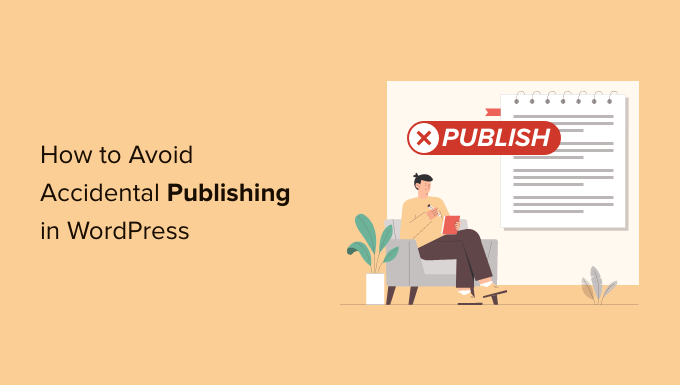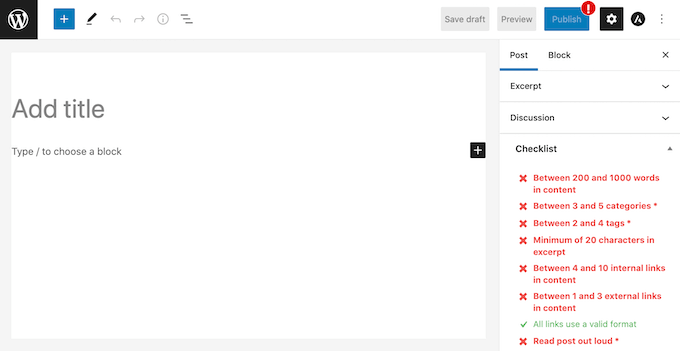After years of blogging and managing multiple WordPress sites, we’ve had our fair share of heart-stopping moments.
You know the ones – where you accidentally hit ‘Publish’ on a half-finished post, or worse, on one that’s barely started. It’s happened to us, and we bet it’s happened to you too.
But here’s the good news: we’re no longer nervous about accidental publishing. Why? Because WordPress now has a built-in way to prevent these mishaps.
In this guide, we will share our proven method to avoid accidentally publishing in WordPress

Why Accidental Publishing on Your WordPress Blog Can Happen
Since the ‘Save draft’ and ‘Preview’ buttons are right next to the ‘Publish’ button in WordPress, you may press the ‘Publish’ button by accident.
Accidental publishing can be a big problem because your posts can get shared and even sent to email subscribers and readers before you get the chance to unpublish them.
If there are some minor errors, then you can just edit a post without unpublishing it on your WordPress website.
If you run a blog with multiple team members, you can even allow authors to revise published posts so that they can make changes themselves.
However, if an incomplete article goes live, then it is a bit embarrassing and can create a negative user experience. Unpublishing the article means your users will see a 404 page when they click on the link from email, social media, or push notifications and try to read your post.
If you have a multi-author blog, then you will also want to make sure your other authors don’t accidentally make a post live before it’s ready.
With that said, let’s take a look at our beginner’s guide on how you can easily avoid accidental publishing in WordPress.
How WordPress Lets You Avoid Accidental Publishing
The WordPress Gutenberg block editor automatically includes an additional confirmation message before you publish a post or page in WordPress.
In the past, this feature had to be added to WordPress by using a publish confirm plugin to configure different settings or adding custom code snippets, but now it’s included automatically.
Now, if you open a WordPress page or post and click the ‘Publish’ button, it won’t publish the article right away.

Instead, it gives you an additional popup confirmation box that asks, ‘Are you ready to publish?’
Then, you will need to click the ‘Publish’ button again to actually make the post or page live. You can also click the ‘Cancel’ button if you clicked publish by mistake.

This additional confirmation message makes it much harder to accidentally publish a post since you’ll need to click the ‘Publish’ button two times.
My Post Still Gets Accidentally Published, What Now?
Even with this accident prevention feature, mistakes can happen.
If the post was published just a few seconds or minutes ago, try unpublishing it right away. This can help minimize its visibility.
If you’re working on updating an already published post but aren’t ready for the changes to go live, learn how to save changes without publishing in WordPress. This skill is important for maintaining your content without accidental changes.
To further prevent accidental publishing and ensure your content is ready, consider adding a blog post checklist to your WordPress editor. This can serve as a final safeguard before hitting ‘Publish’.

Also, add a collaboration feature in the block editor. This allows others to review and contribute to your posts without the risk of accidental publishing.
You also want to learn how to undo changes with post revisions. This feature can be a lifesaver if you need to revert to a previous version of your post quickly.
We hope this article helped you learn how to avoid accidental publishing in WordPress. You may also want to see our expert picks of the best Gutenberg block plugins and how to automatically schedule your WordPress blog posts.
If you liked this article, then please subscribe to our YouTube Channel for WordPress video tutorials. You can also find us on Twitter and Facebook.





Jiří Vaněk
Yes, it has happened to me several times, and it was embarrassing every time. That’s why I eventually switched to Elementor, where this doesn’t happen to me. For this reason, I also applied your excellent guide on delaying articles in the RSS feed to the website. Together with Elementor, this combination ensures that I minimize problems with unwanted article publication.
Dennis Muthomi
this article reminds me when few years ago, I excitedly clicked on a email notification from one of my favorite travel blogs about their new “Summer Getaways” post (something like that), only to be met with a 404 error page.
it was confusing and disappointing ath the same time. That confirmation before publishing feature could have been implemented earlier to prevent such embarrassing situations.
Iain Anderson
Unfortunately I cannot download plugins as I am on wordpress.com. That being the case I hardly see how this is of any help to a “beginner”.
Try giving real assistance to those of us on the .com version of wordpress.
Saud Khan
Is there any way to do the same without plugin?
Alan Thompson
For me the biggest risk is via the WordPress App. When you create a new post in the app, the default state is “publish” so if you save it, you’re publishing it. I always have to remember to manually switch it to draft, then save. I wish they’d make them draft by default!
Saud Khan
Hi, I’ve accidentally published a post and changed the status to draft. Should I noindex & nofollow it and what about permalink?
Matthew Gates
Thank you so much for this! I have only done this once… accidentally published an article that was not ready to go out. Luckily, the WordPress had scheduled it for some time in the far past, instead of “immediate”, so it never got published for anyone to see on the home page. However, my automatic social media feeds that are connected to my site did publish it to the feed. I only discovered this because I get an email when people share their articles on social media, but I had to spend about an hour tracking all the feeds it got published too and deleting the article off the feed. So this will definitely come in handy.
Eric
I’ve actually never had this problem myself and just recently discovered the Editorial Calendar which I think will help organize content for the future so I can plan things out, too.
I like this tip though. You never know, just in case, it’s good to have it there.
Matt
I often just create a scheduled date a long time in the future, then remove it when I want to publish
Jaymes
Thanks for the article.
If I do add the code to functions.php, won’t that be overwritten when a new version of WordPress is released?
WPBeginner Support
No, but it will get overwritten when a new version of your theme is released and you update your theme. This is why we recommend our users to paste snippets in a site specific plugin.
Admin
Artem Russakovskii
Unfortunately, that doesn’t fix the issue for those of us using xmlrpc tools, like Windows Live Writer. I really wish there was a way to build UIs using xmlrpc responses.